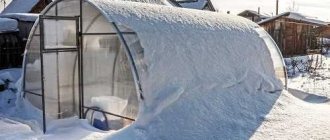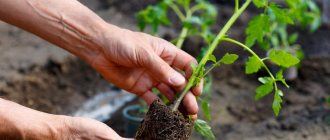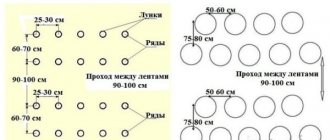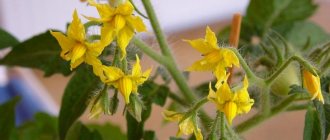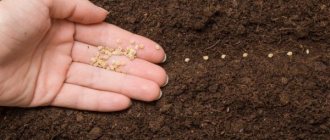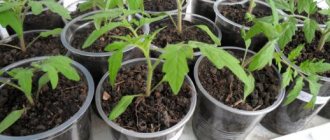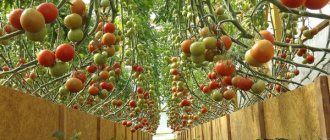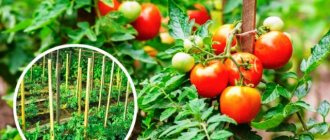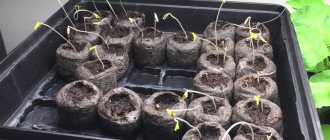Planting tomato seedlings in a greenhouse must be carried out according to all the rules, then it will be possible to get a tomato harvest much earlier than in open ground. It is very important to determine the timing, time, favorable days, when and how to plant seedlings .
Only with proper planting of seedlings in a greenhouse can you get a rich tomato harvest in any growing region. The planting process has its own subtleties, which we will talk about later.
Dates and time of planting tomato seedlings in a greenhouse
The timing of planting seedlings in a greenhouse depends on the technical characteristics of the building:
- Heated - at the end of April.
- From polycarbonate or with additional film cover - in early May.
- Film - after May 15.
The age of the seedlings also plays a big role. Seedlings should have a well-developed root system and 6-8 true leaves. Also, seedlings must be hardened off. This is indicated by the dark color of the stem at the base.
Seedlings are ready for transplanting when the following indicators occur:
- age - 50 days;
- there are 7-10 true leaves.
You also need to pay attention to the air temperature.
Choosing a tomato variety for a polycarbonate greenhouse
So, we plant tomatoes in a polycarbonate greenhouse. First we select the appropriate culture. Which tomato seeds are best to choose? Hybrids are ideal for greenhouses and greenhouses. They are resistant to diseases and produce a stable harvest.
Advice. In polycarbonate greenhouses there are practically no insects that pollinate plants, so choose self-pollinating varieties and hybrids of tomatoes.
On average, the yield of greenhouse tomatoes is 12–15 kg per square meter. m. Tomato hybrids, specially bred for cultivation in greenhouse conditions, produce up to 20 kg of yield per sq.m.
But remember that seed material is not collected from hybrids. The seeds are either sterile or lose quality in the second generation. Before planting, such seeds are not treated to stimulate growth or disinfection. All necessary procedures have already been carried out at the factory.
Attention! If the packaging with seeds indicates that the plants are bee-pollinated, then such tomatoes should not be planted in a greenhouse. They are intended for open ground.
The timing of fruit ripening depends on the characteristics of the variety. Low-growing (determinate) varieties reach technical ripeness earlier than tall (indeterminate) varieties.
When choosing a variety, pay attention to the size of the tomatoes. Large juicy fruits are good for making salads, and medium and small ones are good for canning.
Optimal temperature and features of planting seedlings in the Moscow region, Siberia, the Urals and the North-West
You need to focus on the air and ground temperature:
- the air should warm up to +18-20 degrees;
- soil - up to +13-15 degrees. E
- At night the temperature should not fall below +10°C.
When these indicators are reached, tomato seedlings can be planted in the greenhouse.
The main thing is to do everything on time. There is no need to rush into deadlines, since at low air and soil temperatures, tomato growth slows down and seedlings take longer to recover.
The average daily air temperature should be at least +13 degrees. Planting of seedlings is carried out:
- in the Moscow region - May 1-15;
- in the Leningrad region - May 20-June 10;
- in the Urals and Siberia - from June 15.
The main thing is to look at the temperature indicators and the condition of the seedlings, and do not rush if there is still a risk of a strong drop in temperature.
Timing for planting tomatoes in a greenhouse
The best timing should be determined by referring to the climate of the region and the prevailing weather. Professionals know that planting in greenhouses is carried out at a different time, unlike open ground, depending on the quality of the shelter.
Important! It is prohibited to purchase tomato seeds at promotions or sales, as most often this is how they try to sell expired material. In addition, unpopular seeds of low quality may be presented there.
For ordinary greenhouses, the approximate dates in spring are as follows:
- with heating option - end of April;
- without heating - early May.
Dates are shifted if your region is not located in the middle zone.
How to plant tomatoes correctly
Planting tomatoes must be carried out according to all the rules of agricultural technology, otherwise it will not be possible to get a rich harvest.
Greenhouse preparation
A glass or polycarbonate greenhouse with heating is suitable for growing tomatoes in winter. To protect the bushes from spring frosts, they are temporarily covered with film.
Plastic or metal arcs are placed on the site, and a film is stretched over them. The edges of the film are covered with soil or covered with bricks to protect it from the wind.
A polycarbonate greenhouse can be built in the fall and cleaned and cleaned in the spring.
For a film greenhouse, the frame can also be installed in the fall, and all work can be completed in the spring.
Advice! A polycarbonate greenhouse lasts longer than a film greenhouse.
Before planting, the greenhouse is disinfected to kill all fungal spores, parasites, mold and bacteria.
For metal greenhouses, use a solution of bleach (400 g of product per 10 liters of water). The solution is infused for 5 hours, then everything inside is sprayed with it. After 2 days, boiling water is poured over the frame, and the greenhouse is ventilated.
A greenhouse with a wooden frame is disinfected in a different way. It is necessary to seal all the cracks, lay sheets of metal inside and set fire to a sulfur bomb or a mixture of sulfur and kerosene on them. Next, the greenhouse is ventilated, and the frame is wiped with a solution of copper sulfate.
More details about the disinfection of greenhouses are described in the article: Treatment of polycarbonate greenhouses in spring and autumn...
Soil preparation
Important! Tomatoes cannot be planted in one place for 3 years in a row, so that the seedlings do not become infected with fungal diseases and die.
But even if you adhere to the rules of crop rotation in a greenhouse, there is a possibility that pathogenic agents will remain in the soil.
To prevent seedlings from being affected by fungi, you need to disinfect the soil. For this:
- The top layer of 10-15 cm is removed and a new one is poured.
- the soil is evenly sprayed with a fresh solution of copper sulfate (70 g of the drug per 1 liter of boiling water, after cooling, bring to 10 liters).
- 15 days before transplanting, the soil is dug up, weeds are removed and 3 kg of rotted manure is added per 1 m2.
Experts recommend preparing the soil according to its composition.
- Add 0.5 buckets of sand, turf, humus and sawdust per 1 m2 of peat soil.
- To improve the breathability and porosity of the structure, 0.5 buckets of humus and sawdust are added to loams per 1 m2.
- Add 0.5 buckets of sand and peat per 1 m2 to the black soil.
Planting scheme
Seedlings are planted at intervals of 30-75 cm from each other, depending on the characteristics of the variety.
In a 3x6 meter greenhouse, 2-3 beds are prepared.
- If there are 2 beds, then they are placed near the walls of the greenhouse and made up to 1 m wide. Seedlings are planted using a two-line or square-nest method in a checkerboard pattern. This way you can plant about 60 bushes.
- If there are 3 beds, then 2 are placed near the walls of the greenhouse, each 60 cm wide, and in the middle they make a bed up to 1 m wide - it turns out to be double. Row spacing – 40 cm.
If the greenhouse is of different dimensions, the height of the beds is 30-40 cm from the ground level. Their width can be 60-100 cm, in the row spacing - 40-70 cm.
Seedlings are placed in rows or in a checkerboard pattern:
- Low-growing varieties are planted at intervals of 30-40 cm.
- Tall - 60-75 cm from each other.
The following are planted in a checkerboard pattern:
- Low-growing, ultra-early and early-ripening varieties. In this case, double rows are made with a distance of 50 cm, the bushes are formed into 2-3 stems. Leave 40 cm between bushes.
- Determinate and standard varieties are planted with an interval of 30 cm between bushes and 50 cm between rows.
- Tall varieties are planted with an interval of 60 cm (1 stem and 75 cm (2 stems) between plants and with a row spacing of 70-75 cm.
When growing different varieties, tall bushes are planted closer to the wall, and early ripening ones are given a place near the aisle. After harvesting, early-ripening varieties are removed from the greenhouse, so that tall, later varieties grow well.
Mid-season and late low-growing tomatoes are planted near the walls of the greenhouse, and tall ones are planted near the aisle in the second row. This way low bushes will receive enough light.
Rules for planting tomato seedlings in a greenhouse
We harden the seedlings
For seedlings, transplanting into a greenhouse is a stress that the gardener should minimize. The main thing is to plant fully prepared seedlings.
Preparations begin 2-3 weeks before the planned planting.
Every day the seedlings are taken outside for 1.5 - 2 hours. In the first days, choose a dark place or artificially shade it. Every day the time increases. After 15 days, the seedlings will be well-hardened, so they can be left outside for a day. After 3 days, the seedlings can be planted in the greenhouse.
If it is not possible to take the seedlings outside, you can open the windows indoors all day or take the plants out onto the balcony.
Interesting! In a well-hardened tomato seedling, the lower part of the stem is purple.
You should not reduce the amount of water when watering; it is better to make the time intervals between watering longer. The soil must be completely moistened. The next watering is carried out when the soil is completely dry.
2 days before the procedure, dry and damaged leaves and 2 lower leaves are removed. This is necessary for the speedy development of the first flower cluster. The leaves are cut off, leaving 2 cm so as not to damage the stem. This improves air circulation and allows more light to reach the seedlings.
Seedlings with buds and flowers are sprayed with an aqueous solution of boric acid 4 days before planting. To do this, dilute 15 g of the substance in 1 liter of hot water, wait until everything cools down and then use it.
Seedlings ready for transplantation must have a thick, strong stem, a well-developed root system, and buds on the first cluster.
Watch the video! Planting tomatoes in a greenhouse
Planting tomato seedlings in a greenhouse
Important! Tomato seedlings are transplanted in the late afternoon. First, water it abundantly so as not to damage the root system later.
Step-by-step instruction:
- Dig holes 15 cm deep.
- A handful of wood ash is added to each and watered with a solution of potassium permanganate (1 g of product per 10 liters of water).
- Remove the seedlings from containers with a lump of earth.
- Place 1 plant in 1 hole. There is no need to bury it so as not to slow down the growth of the plant.
- Sprinkle the root with soil and tamp lightly.
- Water each seedling with 1-2 liters of warm water.
- If necessary, install a wooden support next to each hole for future tying.
Selection of planting material
Growing tomatoes in a greenhouse begins with seedlings.
To plant tomatoes in a greenhouse, varieties are selected according to the following criteria:
- Ability to pollinate in closed ground: parthenocarpic (do not need pollination at all) or self-pollinating (each flower simultaneously contains both stamens and pistils). This is the most important criterion, since the bushes grow in a space closed on all sides - with a lack of pollinators, incorrectly selected varieties will not be able to set all the fruits.
- Different ripening periods. Early ripening ones will ripen faster in protected ground. Mid-late and late-ripening tomatoes in greenhouses bear fruit until the first frost.
- Indeterminate. Formed into 1-2 shoots, they bear fruit on two-meter bushes throughout the growing season, which is limited only by the change of season. Tall tomatoes show higher yields in greenhouses than in open beds. In addition, it is easier to tie up a bush, providing reliable support, under a canopy on a frame than to fence a trellis every time.
- Determinant. Shorter bushes are planted closer to the walls of the greenhouse so that the tall ones do not block the light. Varieties with different types of formation get along well under one roof.
Most varieties are universal. But for growing in greenhouses, it is better to choose tomatoes intended for cultivation in protected soil.
Caring for tomatoes after planting
Important! The soil should be constantly moist, but not wet, then roots will begin to form.
Watering
Watering of seedlings is carried out further as the top layer of soil dries. The main thing is not to over-moisten it so that fungal diseases do not develop.
- In May, water 1-2 times a week.
- In June - 2-3 times a week.
- In hot weather, during fruit set, water every day.
Important! Water should not get on the stems and leaves, otherwise it will lead to the development of diseases. Water is used at room temperature.
Loosening
5-6 days after transplantation, the soil is loosened to supply oxygen to the roots.
Tying up
15-20 days after planting in the greenhouse, the tomato bushes begin to be tied up. To do this, take soft garden twine or ties.
For more information on how to tie tomatoes in a greenhouse, read our article: How to tie tomatoes in a polycarbonate greenhouse: materials and tying options, step-by-step photo and video instructions
Stepsoning
It is necessary to plant tomatoes when the bushes grow to 35-40 cm.
Read more about this in our article: How to properly plant tomatoes in a greenhouse: bush formation diagram, care features, photos and videos
How can you plant tomatoes in a greenhouse?
Despite the large number of different crops, only a few can be planted with tomatoes.
- These include the following:
- legumes (beans, beans);
- cabbage and salads;
- watermelons;
- onion and garlic;
- radish;
- strawberry;
- Melissa;
- celery;
- parsley;
- basil.

